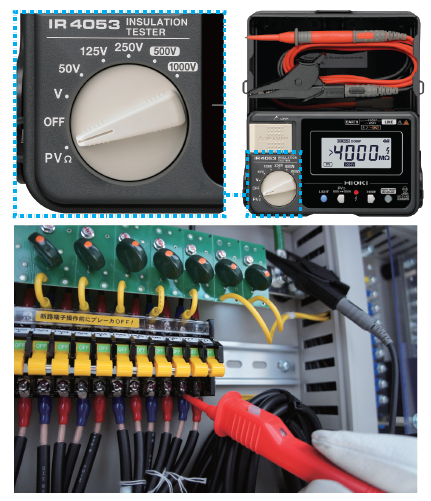





HIOKI IR4053-10 เครื่องทดสอบความเป็นฉนวน
IR4053-10
฿10,800.00(ไม่รวมภาษี)
จำนวน
สินค้าในคลัง9
เครื่องทดสอบความเป็นฉนวนแบบดิจิตอล สำหรับการวัดค่าความเป็นฉนวนของเครื่องผลิตไฟฟ้าด้วยแสงอาทิตย์ ตัวเครื่อง Build-in 5 Range (50, 125, 250, 500, 1000V) ตัวเครื่องทนแรงกระแทกจากการตกสูงสุด 1 เมตร มาตรฐาน CAT III 600V HIOKI, Japan **ราคาพิเศษจากปกติ 12,180 บาท**
Index
IR4053-10 | ฟังก์ชั่นการวัด
Insulation Resistance Measurement
Voltage Measurement
PVΩ Measurement
IR4053-10 | จุดเด่น
Backlight
Drop proof : 1M
Battery power indicator
Auto power off : 10 minutes
Live circuit indicator
Auto. electric discharge
Comparator
Auto. DC/ AC detection
IR4053 ซึ่งออกแบบมาสำหรับ PV สามารถวัดความต้านทานของฉนวนได้อย่างแม่นยำ โดยไม่ได้รับผลกระทบทางไฟฟ้าจาก PV

โดยปกติ ในการวัดความต้านทานของฉนวนของ PV ได้อย่างแม่นยำ เราจำเป็นต้องลัดวงจรวงจรเพื่อได้ค่าที่แม่นยำ ด้วยโหมดการวัด PV ของ IR4053 ไม่จำเป็นต้องลัดวงจร

IR4053-10 | ช่วงการวัด
PVΩ measurement Range : 2000MΩ (500VDC) / 4000MΩ (1000VDC)
Insulation Resistance Measurement Range : 100MΩ (50VDC) / 250MΩ (125VDC) / 500MΩ (250VDC) / 2000 MΩ (500VDC) / 4000 MΩ (1000VDC)
DC voltage Range : 4.2V to 1000V, 4 ranges
AC voltage range : 420V / 600V, 50/60 Hz
IR4053-10 | Power Supply
AA alkaline batteries (LR6) ×4, Continuous operating time: Approx. 20 hours (based on in-house tests)
IR4053-10 | ขนาดสินค้า
159 mm (6.26 in) W × 177 mm H (6.97 in) H × 53 mm (2.09 in) D, Approx. 600 g (21.2 oz) (including batteries, excluding test lead)
IR4053-10 | อุปกรณ์ที่มาในชุด
TEST LEAD L9787 x 1
Neck strap x1
Instruction manual x1
LR6 alkaline battery × 4
IR4053-10 | อุปกรณ์เสริม
TEST LEAD SET WITH REMOTE SWITCH L9788-11
BREAKER PIN L9788-92
TEST LEAD WITH REMOTE SWITCH (RED) L9788-10
TIP PIN L9788-90
TEST LEAD L9787
BREAKER PIN L9787-91
MAGNETIC ADAPTER 9804-02
IR4053-10 | ข้อมูลจำเพาะ
Basic specifications: PVΩ measurement
Rated output voltage: 500VDC / 1000VDC
Effective maximum indicated value: 2000MΩ / 4000 MΩ
Measuring range/ Accuracy: 0.200 to 500 MΩ / ±4% rdg., 501 to 2000 MΩ / ±8% rdg.0.200 to 1000 MΩ / ±4% rdg., 1010 to 4000 MΩ / ±8% rdg.
Other measuring range / Accuracy: 0 to 0.199 MΩ / ±2% rdg. ±6 dgt.
Basic specifications: Insulation resistance measurement
Rated output voltage: 50VDC / 125VDC / 250VDC / 500VDC / 1000VDC
Effective maximum indicated value: 100MΩ / 250MΩ / 500MΩ / 2000MΩ / 4000MΩ
Accuracy 1st effective measuring range MΩ: ±4% rdg. 0.200 to 10.00 / ±4% rdg. 0.200 to 25.0 / ±4% rdg. 0.200 to 50.0 / ±4% rdg. 0.200 to 500 / ±4% rdg. 0.200 to 1000
Lower limit resistance: 0.05 MΩ / 0.125 MΩ / 0.25 MΩ / 0.5 MΩ / 1 MΩ
DC voltage range: 4.2 V (0.001 V resolution) to 1000 V (1 V resolution), 4 ranges, Accuracy: ±1.3% rdg. ±4 dgt., (Ranges in excess of 1000 V are not guaranteed for accuracy.)
AC voltage range: 420 V (0.1 V resolution)/600 V (1 V resolution), 2 ranges, 50/60 Hz, Accuracy: ±2.3% rdg. ±8 dgt., (Ranges in excess of 600 V are not guaranteed for accuracy.)
Display: Semi-transmissive FSTN LCD with back lighting, Backlight
Response time: Insulation resistance range: 1 second, PVΩ function: 4 seconds (based on in-house tests)
Other functions: Live circuit indicator, automatic electric discharge, automatic DC/AC detection, comparator, drop proof, auto power save
Power supply: AA alkaline batteries (LR6) ×4, Continuous operating time: Approx. 20 hours (based on in-house tests)
Dimensions and mass: 159 mm (6.26 in) W × 177 mm H (6.97 in) H × 53 mm (2.09 in) D, Approx. 600 g (21.2 oz) (including batteries, excluding test lead)
Included accessories: TEST LEAD L9787 ×1, Neck strap ×1, Instruction manual ×1, AA alkaline batteries (LR6) ×4
อะไรคือปัญหาของเครื่องทดสอบฉนวนแบบเดิมสำหรับงาน Solar cell ?
ปัญหากับเครื่องมือทดสอบฉนวนแบบเดิมและวิธีการวัด 2 วิธีที่กำหนดโดยแนวทางที่เป็นที่ยอมรับ

Measurement that does not involve a short-circuit
This is not as dangerous, but depending on the circuit status, the measurement may be affected by the generating PV and may produce a result different from the actual insulation resistance.
Measurement that involve a short-circuit
To accurately measure a generating PV, one needs to short the measured circuit, which requires that a short-circuit switch be separately installed. Short-circuiting will also pose the danger of creating an arc. In addition, to minimize hazards, it is recommended that the testing be conducted at night.





